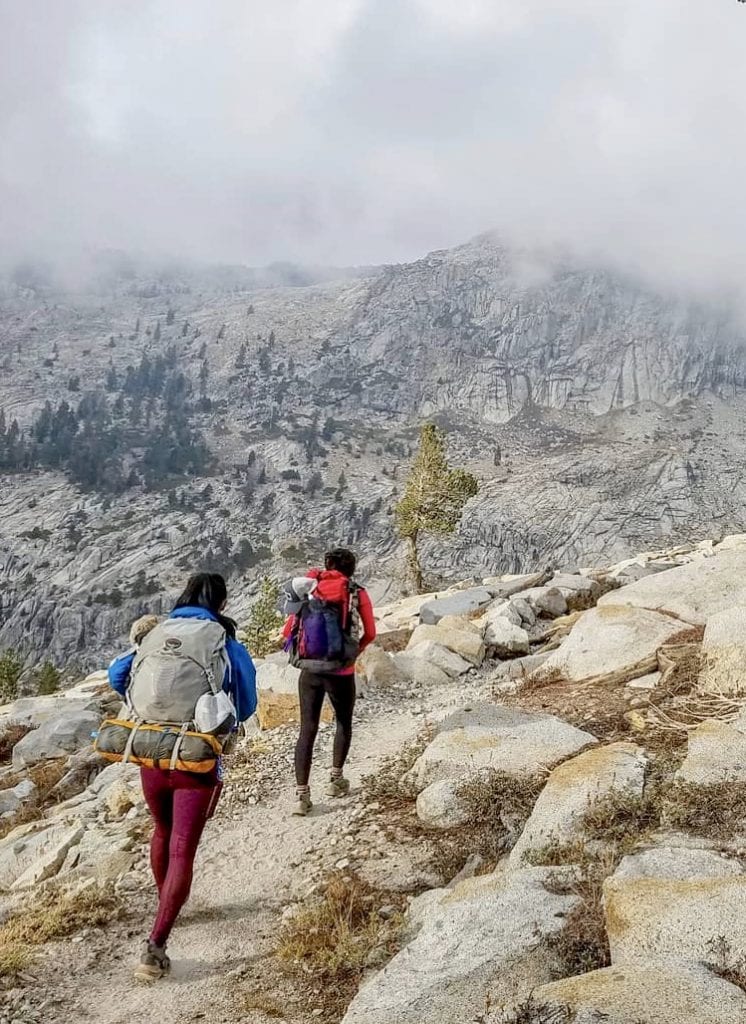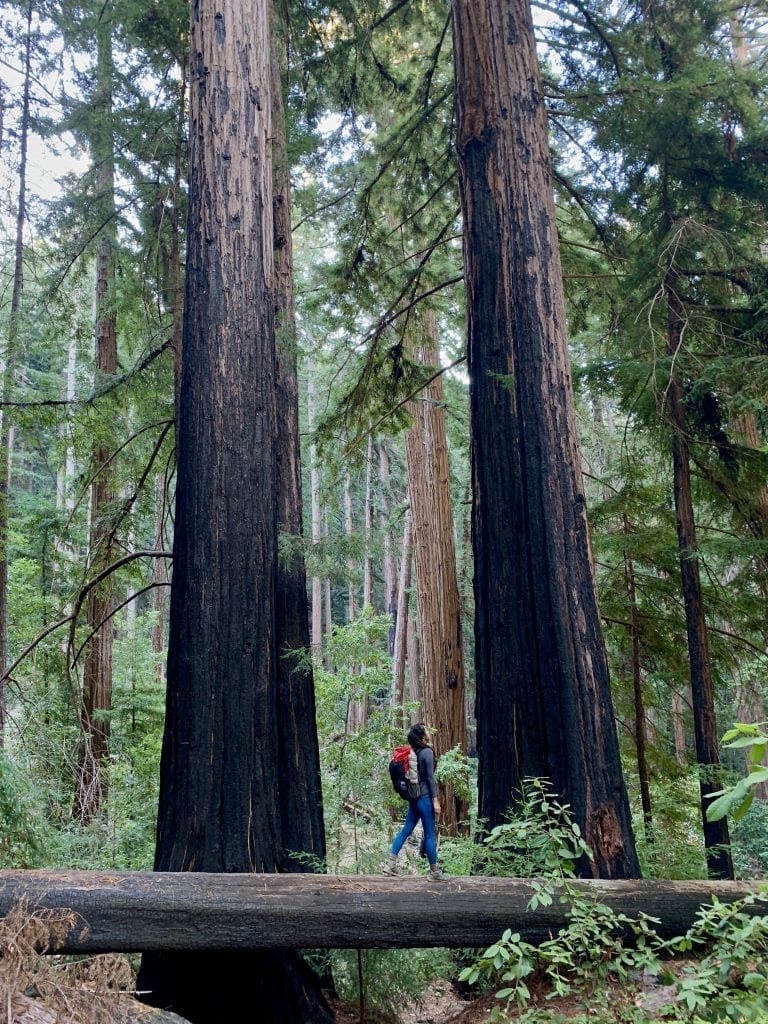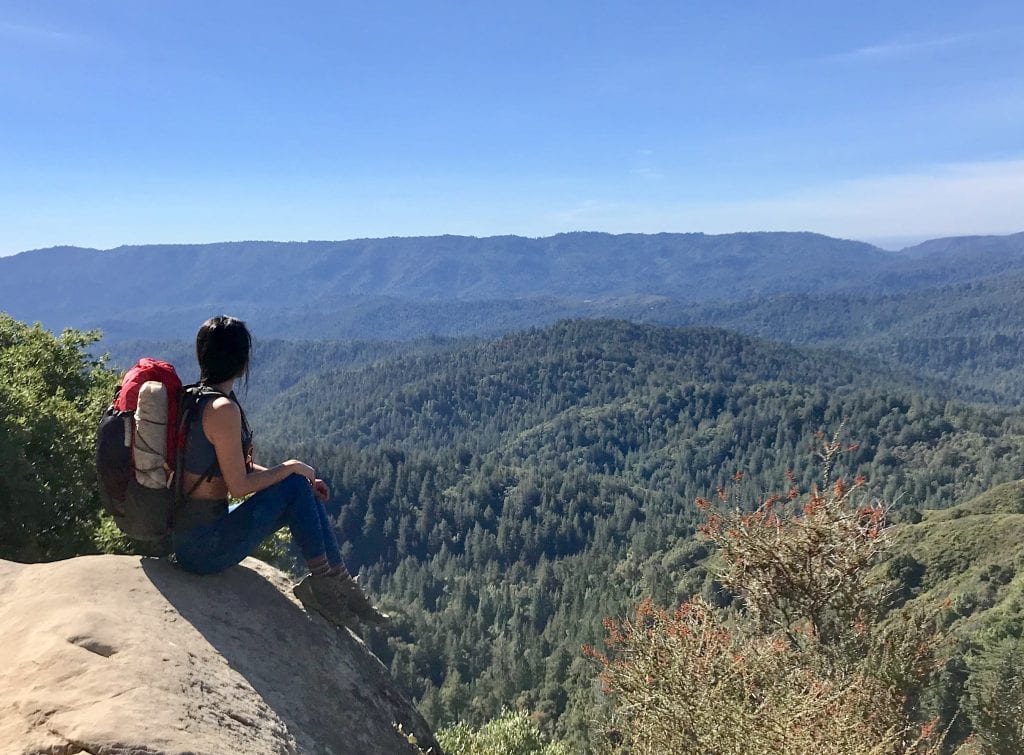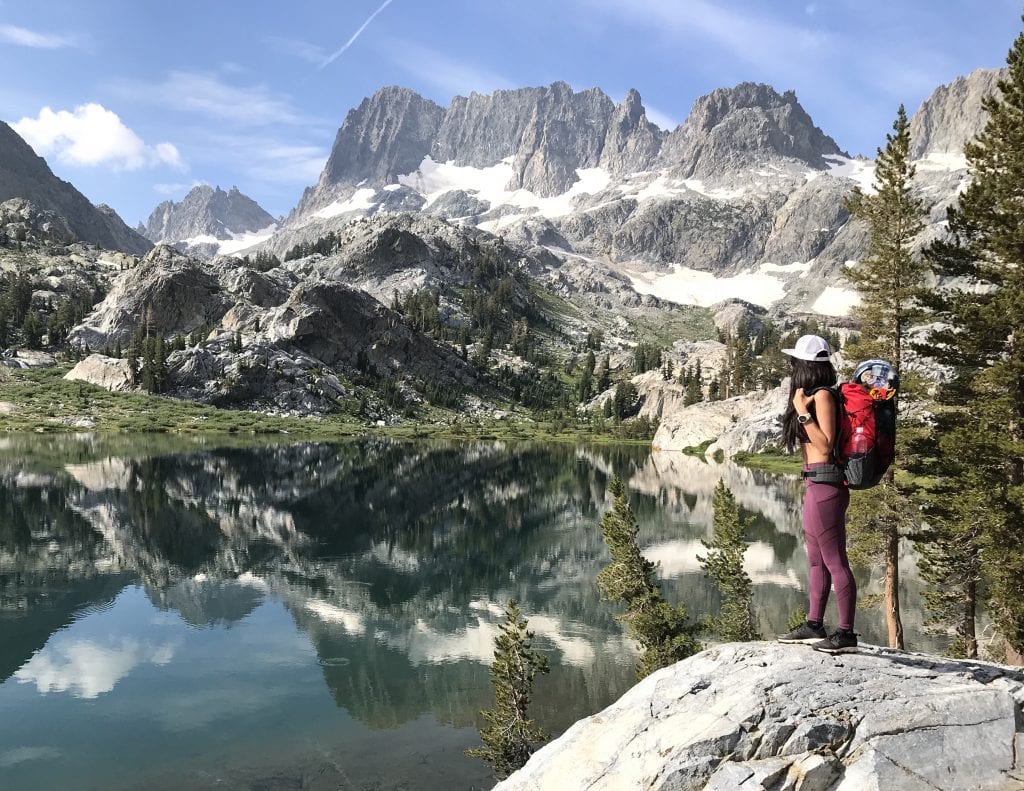In 2018, I transitioned from lightweight backpacking to ultralight (UL) backpacking. It’s been an interesting experience and I’m not hardcore and fully into it (there are definitely a lot of areas I can fully go ultralight on but I’m just not willing to yet), but there are two main adjustments that helped me a lot which I’ll get to in a minute. First, let me give you a breakdown of ultralight backpacking in the way I understand it.*skip to the bottom to see my personal pack list*
The idea behind ultralight backpacking is that the less weight you carry, the more miles you cover for long-distance hiking. Makes sense, right? It’s the mindset of only bringing what you absolutely need to get by on.
Your pack weight is everything including consumables (food and water) and your base weight is everything before consumables. As an ultralight backpacker, your base weight is generally said to be 10 lb and under… but there’s no strict definition of it. I’m not there yet and I’d still consider myself transitioning into it.
Why I Chose Ultralight Backpacking
To put it out there, I wasn’t planning any thru-hikes when I made the transition; one of my close hiking partners made the jump and highly recommended it to me so we could move faster together.
To give you a background of my backpacking weight experience, when I first started backpacking in 2015, my pack weighed 29 lbs (food and water included) but quickly knocked that down to mid-20 lbs. By early 2018, my pack was at 20 lbs. Since I started ultralight backpacking, my pack weight has always been under 20 lbs, but on average my pack weight is 13-15 lbs without the bear canister.
Main Differences in Becoming an Ultralight Hiker
Personally, there have been 2 main factors that stood out most in converting from being a lightweight backpacker to an ultralight backpacker:
- The backpack itself – I saved almost 3 lbs by switching from my Osprey Aura 50 (which I absolutely freaking love still) to my KS50 ultralight backpack. That’s 2.8 lbs automatically shed on every trip…!! The trade-off is comfort – I love the antigravity suspension on the Osprey which also allowed my back to ventilate much better and this was the first backpacking pack I had so I’m not used to a large pack stuck on my back. But if you are used to a traditional pack, then this won’t be an issue for you!
- Clothing! I’m sure this isn’t as big of an issue for men as women, but I want to address this for my female readers – I like bringing a clean set of leggings for every other day (because when you sweat in leggings, it gets pretty gross), maybe an extra baselayer long sleeve and tank top, shorts, socks… you know… just a fresh set of clothes for at least one of the days I’m already in the mountains. But do you know how much space and weight just one extra pair of leggings will take up?! I’ve learned not to bring extra clothes. If it’s cold, I’ll only sweat so much. If it’s hot, I’ll probably just be hiking in my sports bra anyways. Giving up the extra, clean set of clothes really helped with space in my ultralight pack. Don’t get me wrong, I’ll still bring all the extra and necessary layers that I think I’ll need: a down or soft shell jacket, rain gear, shorts because they’re so small, panties just because I do need clean underwear every day (sorry if TMI), & occasionally an extra pair of socks or my down booties.
- One last note to consider: actually – the bear canister. For my old pack, this sits on the top of the inside. For my new pack, it is strapped to the top of the outside of my pack. The idea of it was hard for me to grasp as I kept thinking is that strap really supposed to hold down this rounded container. Won’t it fall over? But it actually works wonders! It stays on snugly for the most part, but I have had it fall over and out a couple of times so just be mindful of that. Keeping it outside the pack does have its perks though… it’s easier to grab snacks! 😉
Quick Tips to Drop Your Pack Weight
- Chances are if you’re reading this, your tent weighs 4+ lbs … get a new tent ASAP! I know, I know, it’s expensive, but I promise it’s worth the investment! There are many backpacking tents now that weigh around 2 lbs!
- Know your water sources – if there’s water along the trail, you don’t need to carry much. Remember, every 1 liter is 2 lbs! I only carry 1 L at a time (sometimes even half) if I know there’s water along the way, but this can change when there’s little-to-no water source.
- My water filter is the best thing ever and my number one recommended piece of gear for its convenience and weight! I’ve already converted all of my closest hiking partners and it’s great for UL hiking because you can even not bring (or if you forget) a water bottle or bladder and drink directly from the water filter bottle. Seriously a game changer!
- Share a bear canister for quick weekend trips – you’ll only need to store food for the night and all your snacks during the day can be kept outside of it. Also… portion control! Bring only what you need.
- Down booties are warmer and lighter than socks for those cold nights
- If you go extreme ultralight, there are options to significantly reduce the weight such as cowboy camping, using a bivy for your shelter, and lighter cook systems… but there are certain comforts that are not worth the trade-off for me.
- Use a bear bag instead of a bear canister when you can (be sure to look up proper food storage in your camp area prior to heading out)
- Leave all your gear bags /storage bags at home and bring only the gear itself

Tiff’s Current Ultralight Backpacking Gear List:
*keep in mind my winter camping gear goes most places with me because I run cold in the mountains, even in the summer… but you can lighten your load depending on the season*
- Backpack: KS50 (495 gram = 17.46 oz = 1.09 lb) or Ry Mountain Gear 38L which weights about 1 lb also
- Tent: Big Agnes Fly Creek HV UL 2 (2 lb 3 oz) but switching to BA Tiger Wall UL2 for an extra 5 oz
- Sleeping bag: Katabatic Gear Palisade 30 Quilt (25.1 oz = 1.57 lb)
- Sleeping pad: Thermarest NeoAir XTherm Max – rectangle (1 lb 1 oz)
- Stove: Jetboil MiniMo (14 oz = 0.88 lb) + fuel (full is 100 gram = 3.53 oz = 0.22 lb) = 1.1lb total cook system
- Water filter: 1 Liter BeFree by Katadyn (2 oz)
- Water Bottle: empty Smart water bottle 1 liter (34 grams = 1.2 oz)
- Headlamp: Nitecore NU25 (with the stock strap it’s 54 gram = 1.9 oz = 0.12 lb // it’s 0.99 oz for headlamp only so you can switch out the straps if you really want to go UL) – it’s also rechargeable!
- Other items for my pack weight which will vary per trip includes: down jacket, rain jacket, spoon, portable battery charger, Garmin Inreach Mini, bear canister and personal items
- Total weight before my ‘other items’ is 120.95 oz = 7.56 lb
The big 3 = shelter, sleep system, and backpack (or some people will say big 4 if you count sleeping bag and sleeping pad separately).
My big 3 or (big 4) weight = 94.56 oz = 5.91 lb






Booking travel soon?
Please consider using my affiliate links below. It costs nothing additional for you but helps me maintain the ever-increasing costs of running a travel blog:
General travel through Tripadvisor here.
Book your flights here.
Book your accommodations here on Expedia, Booking.com, Hotels.com, and VRBO.
Book your car rentals here.
Book your tours here.
Book your travel insurance here.
Other Hiking Gear Guides:
- Backpacking for Beginners: How to Get Started, Tips & Gear
 Disclaimer: This is a beginner’s backpacking guide based off my 9 years of experience. I learned backpacking (backcountry/ wilderness camping in 2015) and have been on countless trips across, and I’m here to share everything… Read more: Backpacking for Beginners: How to Get Started, Tips & Gear
Disclaimer: This is a beginner’s backpacking guide based off my 9 years of experience. I learned backpacking (backcountry/ wilderness camping in 2015) and have been on countless trips across, and I’m here to share everything… Read more: Backpacking for Beginners: How to Get Started, Tips & Gear - Tiff’s Personal Backpacking List
 If you read my previous backpacking guide post, here’s my personal gear list I use. I love my gear and I love gear shopping and researching so I’d highly recommend the products I use… amongst… Read more: Tiff’s Personal Backpacking List
If you read my previous backpacking guide post, here’s my personal gear list I use. I love my gear and I love gear shopping and researching so I’d highly recommend the products I use… amongst… Read more: Tiff’s Personal Backpacking List - Ultralight Backpacking Guide: How to Pack Lighter to Move Faster
 Learn how ultralight backpacking can help you become a faster hiker and enjoy your time in the mountains. Get tips on how to drop your overnight backpack weight and my current and top gear recommendations.
Learn how ultralight backpacking can help you become a faster hiker and enjoy your time in the mountains. Get tips on how to drop your overnight backpack weight and my current and top gear recommendations. - Packing for Patagonia
 Patagonia is a bit of a longer trip and I always thought I would need to pack a lot, but I really didn’t need much. If you haven’t already checked out my blog post from… Read more: Packing for Patagonia
Patagonia is a bit of a longer trip and I always thought I would need to pack a lot, but I really didn’t need much. If you haven’t already checked out my blog post from… Read more: Packing for Patagonia - Best Hiking Shoes for Women 2024
 I have three go-to pair of shoes for the trails: Adidas Terrex Fast Surround hiking boots for lightweight hiking and backpacking, Adidas Terrex Parley hiking shoes for water trails, and Lowa Renegades for a heftier… Read more: Best Hiking Shoes for Women 2024
I have three go-to pair of shoes for the trails: Adidas Terrex Fast Surround hiking boots for lightweight hiking and backpacking, Adidas Terrex Parley hiking shoes for water trails, and Lowa Renegades for a heftier… Read more: Best Hiking Shoes for Women 2024

Can you post a pic/list of your clothing items.
Hi Liz,
I have a lot of different clothing for different conditions but if you let me know what you are looking for, I can send you some recommendations 🙂
Great info for someone like me that is just getting into it. It definetely gives me motivation and courage to go out hiking more.
Thank you, Nathan! I’m glad to hear it’s getting you motivated to get out there! Hiking is such a rewarding activity and it’s a great workout too!
Do you normally pack a first aid kit? Any recommendations for one?
Hi Dustin, I actually don’t have a full first aid kit and wouldn’t know what to recommend. I took a wilderness first aid course and concluded these are the basic essential items I need to bring in case of emergency: self-cleaning gauze (Johnson & Johnson came recommended), Curad tape (can also get from Walmart), and a nonstick dressing. Steri-strips are great for closing wounds but I don’t bring that. I also bring pain killers, pocket knife and my Garmin Inreach Mini. I know there’s a lot of first aid kits out there but before you buy any, make sure you look at all the items inside and evaluate if it’s better to purchase a kit or create your own. Hope this helps!
Also, I don’t bring all of these on all my trips. It varies depending on the trip.
Hey girl! I’m definitely looking into getting a KS backpack and hopefully go on my first backpacking trip! I was just curious if you made any modifications to your pack? I’m def looking into adding a little bit of the back mesh for more comfort! And that’s about it. Anyways, love your blog!!
Thank you so much, Eena! My KS50 is 100% custom made… so yes I guess you can say it’s all modified. I have another pack that is not fully custom with no alterations. A lot of the smaller brands allow you to build out your pack which I love, and if you go with a larger brand like Hyperlite, you can’t customize it. What back mesh are you referring to?
Pingback: Resource Guide for How to Plan An Epic Backpacking Trip | Follow Tiff's Journey
Hi Tiff, thanks for all the helpful info. I am struggling to reduce my pack weight further and was amazed you were able to bet down to the 15lb range. That is half my pack weight. Do you have a complete list of what you bring, such as a Lighterpack list? Seeing ehat others bring is so helpful.
Thanks.
Hi Doug, glad you find this blog helpful! I have my essential pack list at the end of this blog post and in addition to that, I pack the appropriate layers for the season, food, and water. Occasionally I’ll pack a 3lb camera. Let me know if you have any other questions!
Pingback: How Much Should Your Pack Weigh - Backpack to Basics
Tiffany
You have supplied quite a bit of information to traveling lighter. Now, suppose you were going ten days on the John Muir trail, what would your equipment list look like? Besides the basic items, what would your food list encompass?
I am going this coming August and want to see if I can really minimize my pack weight. If I can really get within a forty pound load I will be happy. I will be doing at least one climb on a layover day. Besides Ritter and Banner I would like to through Mt. Goddard out to you. Spectacular!!!! Keep on climbing!!
Cheers
Charlie
Pingback: Backpacking Ansel Adams Wilderness in Mammoth: Minaret Lake Loop | Follow Tiff's Journey
Pingback: Should You Day Hike or Overnight Camp for Mt. Whitney | Follow Tiff's Journey
Pingback: Hike All 7 Big Pine Lakes and Climb Cloudripper 13,517 ft
Pingback: Climb Mount Baldwin 12,624 ft in the Eastern Sierra
Pingback: Kearsarge Pass: Solo Wilderness Trip | Follow Tiff's Journey
Pingback: Beginners Guide to Backpacking in the Mountains - Gear & Tips